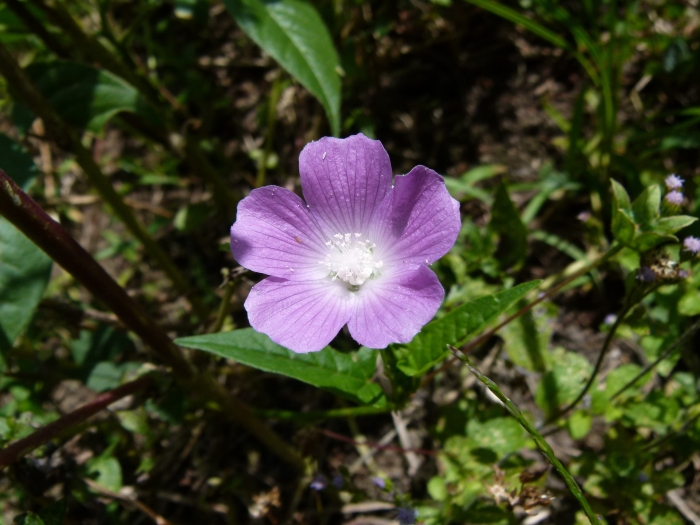Spurred Anoda
(Anoda cristata)
Spurred Anoda (Anoda cristata)
/
/

© botanygirl
CC BY 4.0
Image By:
© botanygirl
Recorded By:
Copyright:
CC BY 4.0
Copyright Notice:
Photo by: © botanygirl | License Type: CC BY 4.0 | License URL: http://creativecommons.org/licenses/by/4.0/ | Uploader: botanygirl | Publisher: iNaturalist |























Estimated Native Range
Summary
Anoda cristata, commonly known as spurred anoda, is an annual herb native to tropical and subtropical regions of the Americas, including the southwestern United States, Mexico, Central America, and South America. It is typically found in habitats such as riparian zones, moist meadows, and disturbed areas, often where there is ample sunlight. Spurred anoda can reach up to 3 feet in height, with branching stems and distinctive triangular, hairy leaves. The plant produces small, lavender to white flowers with a unique, elongated central petal that resembles a spur, hence the common name. Flowering occurs throughout the warm season.
Spurred anoda is not commonly cultivated but can be found in wildflower mixes for naturalistic plantings. It is valued for its ability to attract pollinators, including bees and butterflies. In cultivation, it prefers full sun to part shade and requires moist, well-drained soils. While it is not particularly drought-tolerant, it can thrive in a variety of soil types. Gardeners should be cautious, as Anoda cristata has the potential to become invasive outside of its native range, particularly in warm, humid climates. It is advisable to check local regulations before planting.CC BY-SA 4.0
Spurred anoda is not commonly cultivated but can be found in wildflower mixes for naturalistic plantings. It is valued for its ability to attract pollinators, including bees and butterflies. In cultivation, it prefers full sun to part shade and requires moist, well-drained soils. While it is not particularly drought-tolerant, it can thrive in a variety of soil types. Gardeners should be cautious, as Anoda cristata has the potential to become invasive outside of its native range, particularly in warm, humid climates. It is advisable to check local regulations before planting.CC BY-SA 4.0
Plant Description
- Plant Type: Herb
- Height: 2.25-2.5 feet
- Width: 1-1.25 feet
- Growth Rate: Moderate
- Flower Color: Purple, White
- Flowering Season: Summer
- Leaf Retention:
Growth Requirements
- Sun: Full Sun
- Water: Medium
- Drainage: Medium, Fast
Common Uses
Border Plant, Butterfly Garden, Low Maintenance
Natural Habitat
Native to tropical and subtropical regions of the Americas, including riparian zones, moist meadows, and disturbed areas
Other Names
Common Names: Spurred anoda, Violeta, Amapola, Anoda-Weed
Scientific Names: , Anoda cristata, Anoda acerifolia var. minoriflora, Anoda arizonica, Anoda arizonica var. digitata, Anoda brachyantha, Anoda cristata subsp. brachyantha, Anoda cristata subsp. digitata, Anoda cristata var. albiflora, Anoda cristata var. albiflora
GBIF Accepted Name: